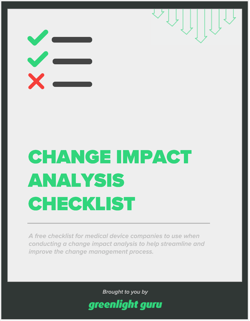
Innovation in medical device technology happens quickly - not only with new product designs, but also with improvements made to existing devices.
There are countless reasons for device changes to occur, from a minor design change to a major overhaul of an operating system. Whatever the reason, for Class 2 devices, these changes need to be documented by the manufacturer, in the form of either a new 510(k) submission or an internal letter to file.
While a letter to file does not decrease testing or documentation requirements, it can be more time and cost effective than a formal submission. How can you be sure you’re making the right call when it comes to making routine changes to your device? Let’s take a look at four costly letter to file mistakes you can’t afford to make.
Letter to File Mistake #1: Not Understanding Regulatory Requirements
A letter to file (LTF) is reserved for design changes that do not need a new regulatory submission. Incorrectly choosing the LTF route could result in major fines, product recalls, and the dreaded Form 483. So, understanding FDA’s parameters for which changes to medical devices do or do not require a new 510(k) are essential.
The regulatory criteria in 21 CFR 807.81(a)(3) state that a premarket notification must be submitted when:
(3) The device is one that the person currently has in commercial distribution or is reintroducing into commercial distribution, but that is about to be significantly changed or modified in design, components, method of manufacture, or intended use. The following constitute significant changes or modifications that require a premarket notification:
(i) A change or modification in the device that could significantly affect the safety or effectiveness of the device, e.g., a significant change or modification in design, material, chemical composition, energy source, or manufacturing process.
(ii) A major change or modification in the intended use of the device
For some time, FDA’s exact definition for where that line is drawn between significant changes and insignificant changes led to confusion among manufacturers. In response, FDA released further clarifying guidance on the matter, acknowledging that some changes are lower risk, and can be appropriately handled internally by following the organization’s own QMS documentation procedures.
However, companies must still comply with the applicable change requirements from FDA’s Quality System Regulation (QSR), which requires manufacturers to review, analyze, validate, and document any changes to design, materials, or manufacturing processes.
Letter to File Mistake #2: Failing to Take a Risk-based Approach to Change Management
The purpose of both a documented letter to file and a 510(k) submission for FDA clearance is to mitigate the potential for risk associated with a given device.
While the Least Burdensome principles may apply, FDA has adopted a risk-based approach to all medical device manufacturing, including the changes made to devices already on the market.
Per FDA guidance, manufacturers are recommended to use an accepted method of risk assessment. However, it does not name specific risk assessment procedures, but rather the kinds of risk assessment activities which will help a manufacturer determine whether to prepare a letter to file or 510(k) submission.
One way to achieve this is with a change impact assessment. Using this method for evaluating risks with a medical device change can answer some important questions, such as: What impact will this product change have? What evidence do I need to gather to support this change? Who else needs to be aware of or involved with this change?
Building off of those general questions, there are three main areas that must be addressed when preparing your letter to file:
-
Description of the change. Describe exactly what is changing. This description can be cut and dry but be sure to be specific with your language.
-
Description of the reason for the change. Explain what prompted the change. This might come from customer complaints or engineering concerns from an internal employee.
-
Justification of the change. Provide all evidence for why the change is acceptable. This would include the results from any testing that proves the change is safe and effective, or documentation to prove that the change doesn’t significantly impact the intended use of the device.
Even in the event FDA believes changes were significant enough to require a formal submission, this kind of detailed reporting will be valuable in any investigation process that ensues.
Letter to File Mistake #3: Ignoring Change Creep
Some device changes may appear so minuscule that it seems anything more than a letter to file would be a waste of FDA’s time. Imagine a supplier changes the color of a device part, or a different kind of screw is used for assembly.
While these individual changes may not have a direct, obvious impact on the safety or performance of a device, they can start to add up until the change is quite significant.
This is what’s known as “change creep,” in which iterative changes made to a device over time result in a product that functions differently than the one originally granted 510(k) clearance. This is similar to “predicate creep,” and it can cause real problems when companies don’t track it.
One easy solution for change creep would be for FDA to introduce a catch-up 510(k) submission. Sadly, this does not exist, meaning manufacturers must find ways to regulate their own letters to file. One strategy for fighting change creep is to include a directive in your quality management system guidelines that limits the number of letters to file allowed at one time without submitting to FDA. For example, the QMS could include a section that requires a new 510(k) submission after no more than 3 documented changes.
Another option would be to wait for a significant change that requires a Special 510(k) submission, and include all the changes for full disclosure. This may receive pushback from FDA during the RTA process, and may require additional discussion with FDA, but it’s worth having that conversation on your terms and timeline, rather than during an FDA inspection.
Letter to File Mistake #4: Using Letter to File as a Shortcut
While it may seem purely bureaucratic, choosing a letter to file is no excuse for lazy engineering. It’s not uncommon for medical device manufacturers who elect the letter to file route to do much less work than they would have done for a special 510(k) submission. This should not be the case.
An improperly used letter to file could cost you far more than it could ever possibly provide. When performed correctly, an internally documented LTF contains the exact same FDA requirements as Special 510(k) submission. Why? Because you’re literally proving substantial equivalence to a predicate device — which, in this case, is itself.
The letter to file isn’t some kind of dodge. This is what we call “doing the work,” of responsible medical device engineering. No matter how insignificant, every change made to your device must undergo risk assessments, validation testing, and proper documentation.
Without these activities—no matter how tedious they may seem—manufacturers cannot accurately evaluate whether a change should be deemed “significant.” Trying to do so willfully negligent. Should the device fail or cause harm during use, you may end up on the hook in a product liability lawsuit.
The fact is, Letters to File must only be chosen following the same moral compass as FDA submissions for the simple reason that it is the right thing to do.
Trace the Impact of Changes to Your Medical Device
An effective change management system helps you not only see, but also understand and appropriately manage any and all changes that occur within your QMS. In order for effective change management to occur, you need to stop reacting to changes and start predicting the impact on your product, processes, and business. Greenlight Guru makes this possible.
With Greenlight Guru, you'll achieve full product lifecycle traceability. Our end-to-end eQMS solution allows you to link any related item within the medical device-specific platform, including change records, documents, risks, design controls, CAPAs, customer complaints, audits and nonconformances - giving you full visibility and control of your quality system.
Ready to learn more? Contact us today for your free personalized demo!
Looking for a design control solution to help you bring safer medical devices to market faster with less risk? Click here to take a quick tour of Greenlight Guru's Medical Device QMS software
Etienne Nichols is the Head of Industry Insights & Education at Greenlight Guru. As a Mechanical Engineer and Medical Device Guru, he specializes in simplifying complex ideas, teaching system integration, and connecting industry leaders. While hosting the Global Medical Device Podcast, Etienne has led over 200...
Related Posts
Understanding FDA’s Special 510(k) Program
How the Design Control Process Applies to a 510(k) Premarket Notification
What is a Predetermined Change Control Plan (PCCP) and Who Needs One?
Get your free resource
Change Impact Analysis Checklist











